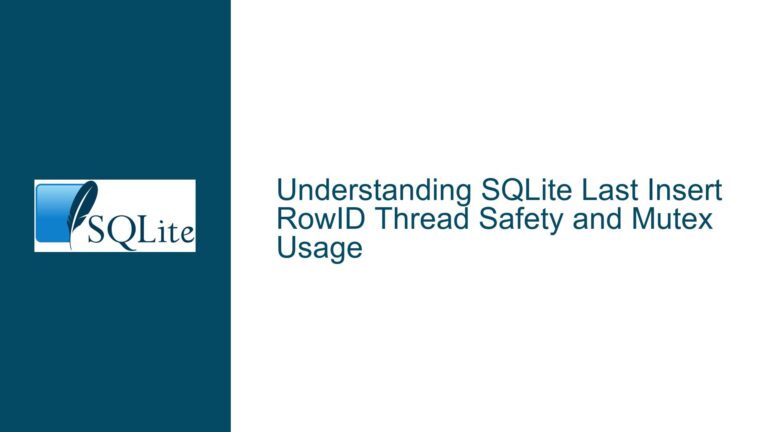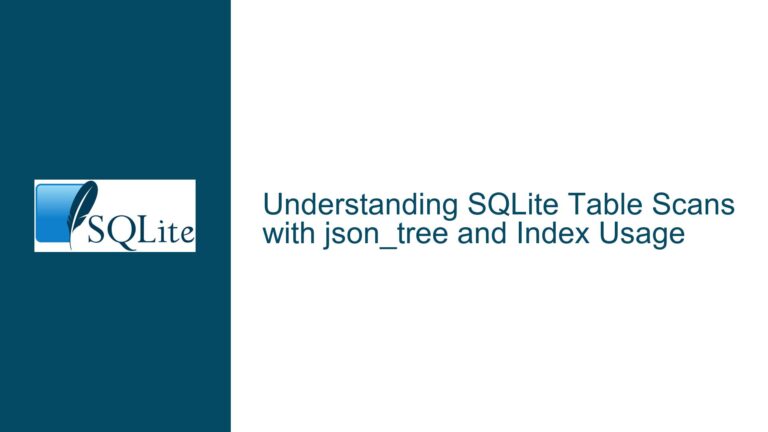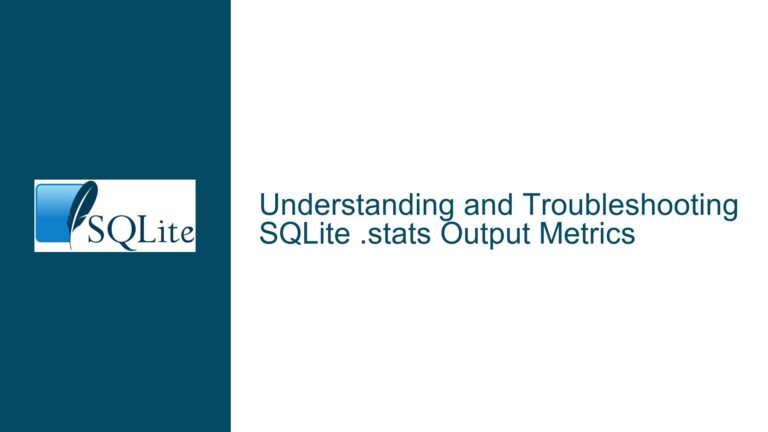Optimizing Multiple Column Updates via Single-Pass SQLite Table Scans
Understanding the Impact of Sequential Full-Table Scans on Update Performance
SQLite’s architecture is designed for efficiency in embedded environments, but certain update patterns can inadvertently degrade performance. When executing multiple UPDATE statements on the same table, each with its own WHERE clause and column assignments, the database engine performs a full table scan for every individual statement. This means that for N update operations, the entire table is read from disk N times. Even if each update targets a small subset of rows, the cumulative I/O and computational overhead grows linearly with the number of statements.
Consider a scenario where four updates are applied to columns col1 through col4 in a table t. Each UPDATE scans all rows, evaluates its condition (e.g., typeof(col1) = 'text'), and modifies the target column if the condition is met. While the conditions and expressions may be independent, the repeated scans introduce redundant disk reads, increased lock contention, and transaction log flushes. For large tables, this multiplies the time required to complete all updates. Furthermore, SQLite’s write-ahead logging (WAL) or rollback journal mechanisms amplify write operations when rows are modified across multiple transactions.
A critical nuance lies in how SQLite handles row updates. When a row is updated, the entire row is rewritten in the database file unless the storage engine detects that the new row is identical to the old one. This means that even if two consecutive updates modify different columns of the same row, the row is written twice. Combining these operations into a single update reduces the number of row rewrites. However, achieving this requires careful structuring of the update logic to avoid unintended side effects, such as triggering update hooks or activating unintended constraints.
Key Factors Contributing to Inefficient Multi-Column Update Operations
The inefficiency of sequential updates stems from three interrelated factors: redundant data traversal, write amplification, and trigger/constraint re-evaluation.
Redundant Data Traversal: Each
UPDATEstatement in SQLite must scan the entire table unless an index exists to satisfy theWHEREclause. When multiple updates target different columns with conditions that cannot use indexes (e.g.,typeof()checks orIS NULLpredicates), the absence of a single-pass strategy forces repeated full scans. This is particularly costly for tables stored on slower media or in environments with limited memory for caching.Write Amplification: SQLite’s storage engine writes entire rows to disk whenever any column value changes. If four separate updates modify four different columns in the same row, the row is written four times. This write amplification consumes I/O bandwidth and increases the risk of fragmentation in the database file. Even if a column is updated to the same value (e.g.,
col1 = col1), older SQLite versions may still rewrite the row, though recent optimizations skip writes when values are unchanged.Trigger and Constraint Overhead: If the table has
AFTER UPDATEtriggers, each individualUPDATEstatement fires the trigger for all rows it modifies. When multiple updates affect overlapping rows, triggers execute multiple times for the same row. This can lead to redundant trigger logic execution, such as logging or validation steps, unless the trigger includes conditions to filter self-assignments.
A secondary factor is transaction management. By default, each UPDATE runs in an auto-commit transaction. Combining multiple updates into a single statement allows them to execute within a single transaction, reducing the overhead of transaction commits and journal synchronization.
Strategies for Consolidating Multi-Column Updates into a Single Scan
The optimal solution involves rewriting the series of UPDATE statements into a single statement that conditionally modifies columns based on row-wise evaluations. This approach leverages SQLite’s CASE expression and a consolidated WHERE clause to ensure that each row is processed once, and only necessary modifications are applied.
Step 1: Combine Column Assignments Using CASE Expressions
Convert individual UPDATE statements into a single statement where each column is assigned a CASE expression that checks its specific condition:
UPDATE t
SET
col1 = CASE WHEN condition1 THEN expr1 ELSE col1 END,
col2 = CASE WHEN condition2 THEN expr2 ELSE col2 END,
col3 = CASE WHEN condition3 THEN expr3 ELSE col3 END,
col4 = CASE WHEN condition4 THEN expr4 ELSE col4 END;
Here, condition1 through condition4 are the original WHERE clauses from the individual updates, and expr1 through expr4 are the corresponding assignment expressions. The ELSE colX clause ensures that if a row does not meet the condition for a column, the column retains its existing value, avoiding unnecessary changes.
Key Insight: Modern SQLite versions (3.15.0+) optimize CASE expressions to prevent redundant writes. If the CASE evaluates to the column’s current value, SQLite skips writing the row, mitigating write amplification.
Step 2: Filter Rows Using a Consolidated WHERE Clause
To exclude rows where no columns require modification, add a WHERE clause that combines all conditions with OR:
UPDATE t
SET
col1 = CASE ... END,
...
WHERE condition1 OR condition2 OR condition3 OR condition4;
This ensures that the update operation only touches rows where at least one condition is true. Rows unaffected by all conditions are skipped entirely, reducing the number of rows read and processed.
Step 3: Address Trigger and Constraint Implications
If the table has AFTER UPDATE triggers, the consolidated update will fire the trigger once per modified row, regardless of how many columns are changed. To mimic the behavior of individual updates (where a trigger fires only for rows modified by a specific column’s update), add WHEN clauses to the trigger that check which columns were altered:
CREATE TRIGGER t_after_update AFTER UPDATE ON t
FOR EACH ROW
WHEN NEW.col1 IS NOT OLD.col1 OR
NEW.col2 IS NOT OLD.col2 OR
NEW.col3 IS NOT OLD.col3 OR
NEW.col4 IS NOT OLD.col4
BEGIN
-- Trigger logic here
END;
This ensures the trigger executes only if at least one column’s value changes during the update.
Step 4: Validate Index and Storage Optimizations
After implementing the consolidated update, analyze the database’s performance using EXPLAIN QUERY PLAN to verify that the update uses a single table scan. For example:
EXPLAIN QUERY PLAN
UPDATE t ...;
The output should show SCAN TABLE t, indicating a single pass. If indices are used (unlikely for typeof() or IS NULL conditions), ensure they do not introduce unintended overhead.
Step 5: Benchmark and Compare Execution Plans
Measure the performance difference between the original and consolidated update strategies. Use SQLite’s sqlite3_profile() function or external tools to track I/O operations and execution time. For large tables, the consolidated approach should show significant reductions in disk reads and writes.
Advanced Consideration: For tables with extremely large rows or numerous columns, test the impact of updating multiple columns in a single pass versus batched updates. In rare cases, SQLite’s page size and overflow mechanisms may influence the optimal strategy.
Summary of Key Fixes and Best Practices
- Use
CASEExpressions: Combine multiple column updates into a single statement with conditional logic. - Leverage
WHEREClauses: Filter rows to process only those requiring changes. - Optimize Triggers: Modify triggers to account for multi-column updates.
- Monitor Write Amplification: Confirm that unchanged columns do not trigger row rewrites.
- Profile Performance: Validate execution plans and I/O patterns with SQLite’s diagnostic tools.
By adopting these strategies, developers can transform inefficient multi-pass update operations into streamlined single-pass updates, significantly enhancing performance in SQLite-based applications.






